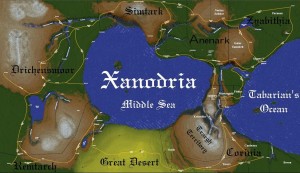The Face

The Face is dominated geographically by two large bodies of water. The aptly-named Middle Sea is roughly centered, covering a full third of the Face’s length, and over half its breadth. It is known to hold a number of islands, but their exact size, location and even number is only guessed at due to the interdiction of cross-sea travel by Elves and pirates. Recent verbal accounts of the Middle Sea islands by refugee “Belgar” are considered apocryphal at best. In the East, Tabarian’s Ocean extends over at least half, if not two-thirds the area of the Middle Sea. If Tabarian’s Ocean did not exist, Zyabithia, Corinia, and Anenark would hold equally as much land as Drichensmoor and Remtarch. This difference in territory size is largely mitigated by the strategic and economic implications of the additional coastline.
In the South, we find the Great Desert. Since the Famine Year which marks its formation, it has largely prevented overland travel between Corinia and Remtarch, except by small merchant parties who have gained the assistance of the Chemurgin. Without the guidance and truce of these nomadic people, attempting a crossing is tantamount to suicide, though military action has forced it on occasion (with serious losses).
To begin our overview of the formal nations of the Face, we will start with the acknowledged birthplace of civilization, Drichensmoor. Comprising almost the whole of the West, it is home to two mountains, and the largest lake on the Face, Goran’s Deep. Its varied terrain make it the source of most spices, and it hosts large deposits of all metals. Drichensmoor’s capital is Navara.
Remtarch, to the South, is left with the dregs of the West, butted up against the Great Desert. The land is scarcely arable. Only the notorious determination of its citizens, and a sizeable lake with a navigable river connection to the coast allows it any economic presence at all. The capital (and only true city) of Remtarch is Ritsark
In the central North, we find Simtark. A small country, but almost no part of it is more than 30 leagues from a navigable river or the coast itself, allowing considerable ease of trade. Bows made from quality Simtarkan trees are valued across the Face, though they never show their true glory except in the hands of a native. Many common Simtarkans roam the hills, seeking forage for their herds or flocks. Insofar as they can be said to have one, Simtark is also “home” to the Breezies. Simtark’s capital, still recovering from being sacked by Drichensmoor and ravaged by Damien himself, is Dariac.
To the Northeast lies Zyabithia. The so-called “Gem of the East” boasts impressive reserves of lumber and grain. Its deposits of iron, while small, deliver steel of conspicuous strength, making it sought after. They have leveraged that strength, producing the Face’s finest swordsmen. The capital city is Tirrian Paveral.
Sandwiched between Simtark and Zyabithia is Anenark. The newest of the six nations, it was formed by lords from Simtark and Zyabithia pledging their lands and fealty to the former High King of the Treaty of Gaith, Corwyn Blackwolfe. Anenark’s capital is Drapier.
Finally, in the Southeast we find Corinia. It is here that wild horses were first put to use as transportation or labor rather than food. With few other natural resources, most common Corinians are farmers. It was only natural that horses began to be bred in farms as well as captured in the wild. Corinia is also home to the Traeghi Mountains, so named for the barbarian tribes which inhabit them. Some say Corinians actually learned horsemanship from the Traeghi, though none (but the Traeghi) say it loudly. The capital of Corinia is Anvar.